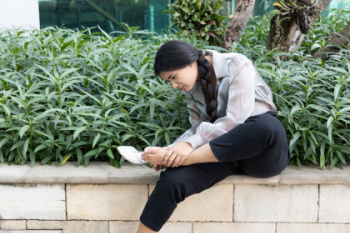
Foot blisters are often uncomfortable, and arise from various factors that warrant attention for prevention and management. Friction is a primary reason, occurring when repeated rubbing or pressure against the skin creates a separation between the layers of the skin, leading to fluid accumulation and blister formation. Wearing ill-fitting footwear, particularly shoes that are too tight or loose, can cause friction and increase the risk of blisters. Additionally, excessive moisture, such as sweat or wet conditions, softens the skin, making it more susceptible to friction-induced blisters. Activities that involve repetitive movements, like running or hiking, further heighten the likelihood of developing blisters. Moreover, certain foot deformities or abnormalities, such as bunions or hammertoes, may predispose individuals to blister formation due to altered pressure distribution. If you have developed foot blisters, it is suggested that you confer with a podiatrist who can offer effective treatment and prevention techniques.
Blisters are prone to making everyday activities extremely uncomfortable. If your feet are hurting, contact one of our podiatrists of American Surgeons Group. Our practitioners can provide the care you need to keep you pain-free and on your feet.
Foot Blisters
Foot blisters develop as a result of constantly wearing tight or ill-fitting footwear. This happens due to the constant rubbing from the shoe, which can often lead to pain.
What Are Foot Blisters?
A foot blister is a small fluid-filled pocket that forms on the upper-most layer of the skin. Blisters are filled with clear fluid and can lead to blood drainage or pus if the area becomes infected.
How Do Blisters Form?
Blisters on the feet are often the result of constant friction of skin and material, usually by shoe rubbing. Walking in sandals, boots, or shoes that don’t fit properly for long periods of time can result in a blister. Having consistent foot moisture and humidity can easily lead to blister formation.
Prevention & Treatment
It is important to properly care for the affected area in order to prevent infection and ease the pain. Do not lance the blister and use a Band-Aid to provide pain relief. Also, be sure to keep your feet dry and wear proper fitting shoes. If you see blood or pus in a blister, seek assistance from a podiatrist.
If you have any questions, please feel free to contact our offices located in Homewood, South Chicago Heights, and Mokena, IL . We offer the newest diagnostic and treatment technologies for all your foot care needs.
